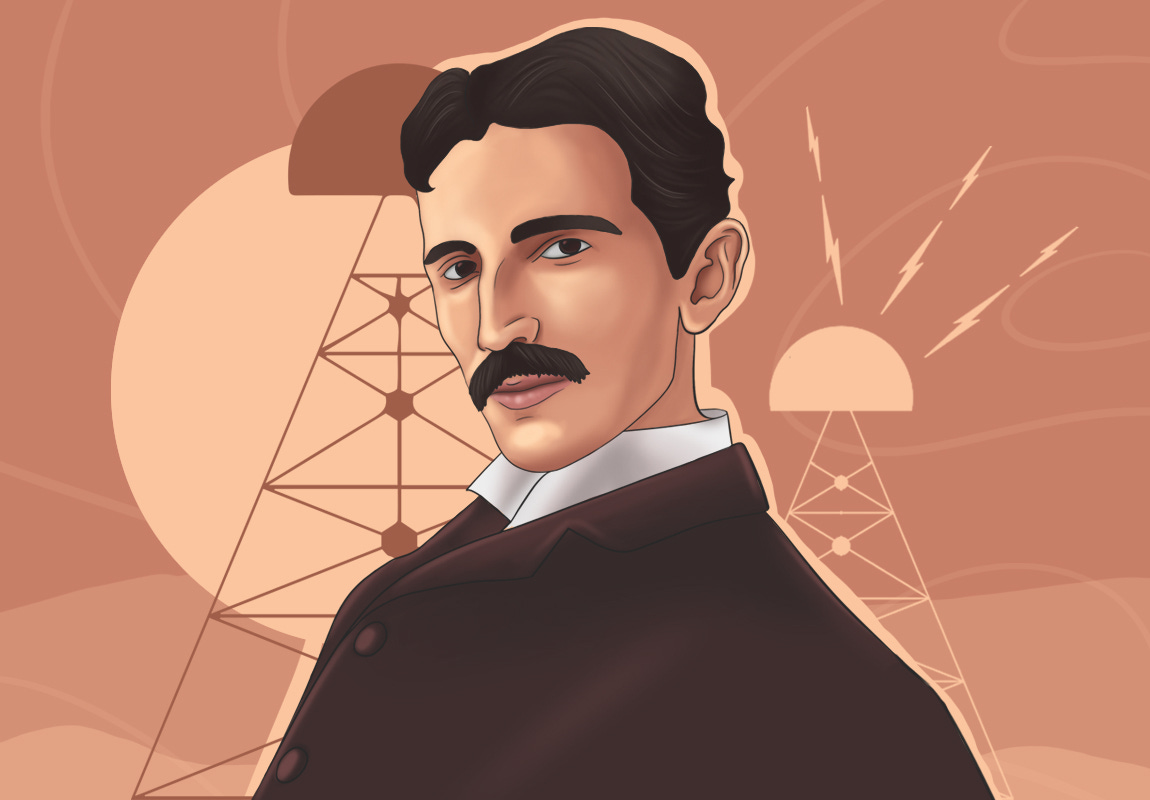The story of the feud between Thomas Alva Edison and Nikola Tesla is well known in the scientific world. What is the reality behind their ‘war of the currents’? In this article we will be examining this in the context of the life of Nikola Tesla. Despite the numerous useful inventions to his credit, the great Nikola Tesla had to live life penniless, having no one to care for him.
At the age of 28, Nikola Tesla went to USA from the village of Smiljan in Croatia in search of a new way of research and approached 37-year-old inventor and businessman Thomas Alva Edison. From then on, Tesla’s life began to change. Tesla, who worked as Edison’s apprentice, later became his biggest rival.
Tesla worked under Edison for a year and later moved on, but the rivalry between them intensified. The story of the cold war between the two in the name of science, or the discovery of the electric current, is always a topic of discussion in the world of science. The ‘war of the currents’ of the 1880s was over whose electrical system would power the world – Tesla’s AC (alternating current) system or Edison’s DC (direct current) system.
Child prodigy
Nikola Tesla was born on July 10, 1856, in the village of Smiljan, when it was a part of the Austrian Empire. Today, this area is a part of Croatia. His father was an Orthodox priest. Tesla grew up in a Serbian Orthodox family. His mother, Duka Mandic, was very good at making household items and had good memory. Tesla has said that he had inherited the same memory and ability from his mother.
Tesla demonstrated extreme interest and intelligence in mentally solving complicated mathematical problems during his childhood itself. In those early days, his teachers found it difficult to believe that Tesla was solving problems so easily.
Tesla enrolled at the Imperial Royal Technical College. He was a brilliant student in his early years, but by the time he was in his final year at the polytechnic school, he dropped out. He drifted away from his family and home at that time and started to make a living by doing odd jobs. His father found him and brought him back home to make him resume his studies.
After his father’s death, Tesla was sent to Prague to study with the help of his relatives. Since he was late to join the university, he had trouble getting up to speed with the languages, which included Greek, and hence could not score good marks there.
Tesla, who was doing odd jobs and getting by, later developed a desire to do something on his own. He had gained expertise in the field of electrical work and had designed dynamos, motors and generators. He then went to New York with a desire to do something on his own.
‘War of the currents’
Nikola Tesla was a genius whose inventions and discoveries changed the world. He focused on his inventions rather than on fame and was constantly involved in controversy. The most notable of these was his disagreement with Edison over two breakthroughs in electrical engineering. During his time as Edison's assistant, Tesla excelled in installing generators and other equipment in the laboratory and designing new machines.
Later, Tesla developed a new scheme for utilising alternating current for induction motors. This discovery led to a subsequent rivalry with Edison. Direct current (DC) discovered by Edison was widely used in the United States at that time. The low-voltage current from power plants could not be transmitted over long distances like high-voltage currents. To overcome these problems, small power plants had to be set up intermittently near customers.
Edison generally organised campaigns to promote his DC, but AC gained popularity in the United States as it was more efficient than Edison‘s DC.
Tesla’s alternating current (AC) found a solution to this problem. Installing transformers, adjusting the voltage variation and setting up power plants miles away from the customer was no longer a problem. As he could not promote it by himself, Tesla sold the patent to an American businessman, George Westinghouse. This was a major setback for Edison. The feud lasted for some time to decide whose invention would be recognised more by the future generation. This came to be known as the ‘war of the currents’.
Tesla held over 270 patents in 27 countries around the world, including a rotating magnetic field and a three-phase electric power transmission system.
Edison generally organised campaigns to promote his DC, but AC gained popularity in the United States as it was more efficient than Edison‘s DC. Thus, with the help of George Westinghouse, Tesla’s discovery became beneficial to the world.
According to his biographer, Bernard Carlson, Tesla was not worried about the alleged cold war with Edison. He said the power struggle should only be seen as a trade war that lasted just for a short time.
Tesla held over 270 patents in 27 countries around the world, including a rotating magnetic field and a three-phase electric power transmission system. Of those, 112 patents were from the US alone. Tesla later sold the patent rights of his alternating-current dynamos, transformers and motors to George Westinghouse. Many of the electronic devices we use today have the Tesla coil that is still not outdated and serves as a stimulus to newer versions.
Marconi given radio patent
The Tesla coil and induction coil used for radio technology was invented by Tesla in 1891. The Tesla coil is the component used in all the electronic devices we see today, such as radios and televisions. That same year, Tesla became a US citizen.
On March 1, 1893, Tesla demonstrated how to transmit energy through wireless transmission. An induction coil was also built to send and receive radio signals. Guglielmo Marconi came up with the idea of the radio while Tesla was preparing to send signals to distant lands.
Meanwhile, misfortune struck, and Tesla’s laboratory caught fire. Undeterred, Tesla resumed operations in 1897. At that time, he applied and waited for a patent. He received two more patents related to the radio in 1900, but, in 1904, the Patent Office granted Marconi a patent for his invention of the radio. According to the article Nikola Tesla’s Contributions to Radio Developments written by Aleksandar Marinčić , Zorica Civrić , Bratislav Milovanović, Tesla’s name was even omitted in the great story of the radio, an invention that was based on his findings.
It was because of these reasons that despite all his inventions, Tesla did not get the recognition he deserved. Even today, sadly, the genius of Nikola Tesla does not get the attention and acclaim that a Tesla car gets.
Unsung hero
Tesla did not have as much business acumen as the inventors and scientists of those days. His focus was on inventions that would be useful for future generations.
Tesla, who started his own laboratory, was unable to get recognition and fame for the results of his research, his skills, and the many world-famous discoveries that followed. In 1895, Wilhelm Roentgen made discoveries such as the X-ray by following in the footsteps of Tesla’s experiments with electromagnetic waves. To allay people’s fears and perceptions about alternating current, Tesla even demonstrated passing electricity through his body.
Tesla designed the first hydroelectric power plant to generate electricity from the Niagara Falls. In 1898, he successfully operated a remote-controlled ‘teleautomatic’ boat.
The discovery of terrestrial stationary waves in the early 1900s was the first step toward wireless communication. He proved that the Earth is a conductor of electricity and that it can resonate at certain wavelengths.
More setbacks
Tesla handed over 51% of his telephone and telegraphy patents to American John Pierpont Morgan to promote wireless communication, transmitting messages, images, and other information anywhere in the world. Tesla was paid $ 150,000 for his work. He erected a wireless world-broadcasting tower, but the project did not materialise. Tesla had to abandon the project, and this was one of the biggest setbacks of his life.
Because of financial difficulties, many of Tesla’s ideas were confined to books. Despite being a brilliant man who made so many inventions and discoveries, Tesla lived his life penniless and alone in a single room in New York. According to Smithsonian magazine, in that solitary life, he spent his days not talking to anyone, but telling stories only to pigeons in New York City parks and caring for them.
Nikola Tesla died on January 7, 1943, in his room in New York.
Today, the Nikola Tesla Award honours inventors and scientists who have made significant contributions to the field of electricity.
Now put on your thinking hats and think about the following questions for a couple of minutes.
Can you think of the differences between Alternating Current (AC) and Direct Current (DC)?
How would you describe the contributions of Nikola Tesla in the field of electricity?
Write down your thoughts and discuss them with your students, children and your colleagues. Listen to their views and compare them with your own. As you listen to others, note how similar or different your views are to others’.
Thank you for listening. Subscribe to The Scando Review on thescandoreview.com.
Happy Teaching!













Nikola Tesla and the ‘War of Currents’